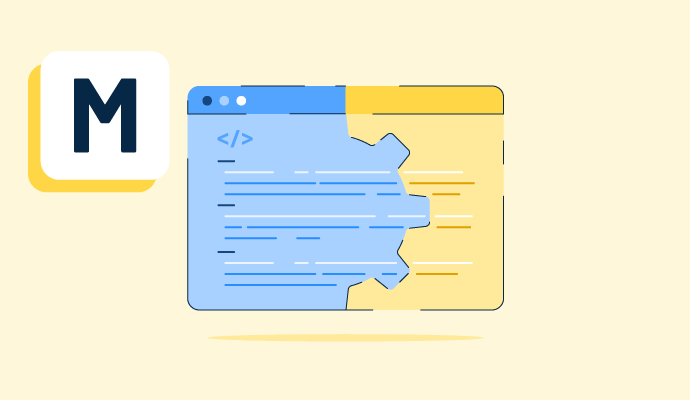What is middleware?
Middleware is software that helps various applications communicate with one another. It offers the ability to intelligently and effectively connect applications while providing faster innovation.
Middleware serves as a link between various tools, technologies, and databases to create seamless system integration. A unified service is then offered to users by the single system.
For instance, users of a Windows frontend application may send and receive data from a Linux backend server without realizing the difference. Many companies rely on message queue (MQ) tools that use the publisher/subscriber pattern to enable process-related communication between IT systems.
Types of middleware
Middleware plays a critical role in modern enterprise architecture, providing a flexible and scalable solution for integrating and managing complex systems. It comes in various types, such as:
- Database middleware facilitates communication between databases and other applications. Its main goal is to gather all data from local and remote databases. It completes tasks using two different database types, namely, native database middleware and call-level interfaces (CLI). CLIs have full access rights to various relational databases via a standard interface. On the other hand, native database middleware uses native techniques to capture all features and functionality of a particular database.
- Remote procedure call (RPC) is a traditional middleware that works as a client/server principle. Here, without having any prior knowledge of the network, one client machine can send any service requests to a program running on another computer over the network. RPC middleware uses point-to-point communication, making it non-scalable and resource-intensive while processing.
- Object middleware’s primary goal is to manage communication between all objects in a distributed computing system. Using an object-oriented system, object middleware transfers all requests and objects from one system to another over a computer network.
- Web application servers function as middleware between browsers and other systems to create better user interfaces for various applications. App servers allow a wide range of server-side processing.
- Message-Oriented Middleware (MOM) facilitates sending and receiving all messages across various distributed application types. It makes using all applications across various platforms less complicated and makes working with network protocols and operating systems more comfortable. Email is a primary example of message-oriented middleware.
- Portals, also called enterprise portal servers, perform all functions like middleware because they have seamless front-end integration. Its primary goal is to enable communication among client devices and back-end systems.
- Embedded middleware links real-time operating systems and embedded applications, facilitating communication and integrating services with software interfaces.
- Application programming interfaces (APIs) are a collection of tools and protocols that aid in designing various applications and enabling communication between secondary applications and services and primary applications without requiring knowledge of implementations on either side.
- Content-centric middleware is made for developers who only need to extract a small portion of the system's content and are unfamiliar with how to do so.
Middleware architecture
Middleware software architecture comprises several interconnected parts that work together to form a data pipeline. Through the middleware, the data is transferred from one connecting application to another. The data is processed by the middleware for compatibility.
Common middleware software parts are as follows:
- Management console provides software developers with an overview of the middleware system's operations, software rules, and configurations.
- Client interface is the outer part of middleware software communicating with the applications.
- Middleware internal interface works as the software glue holding various components together. The middleware components use the internal interface to work together with their protocol.
- Platform interface guarantees cross-platform compatibility for the middleware programs. It has software elements that can be used with various operating systems.
- Contract manager establishes the guidelines for data exchange in the middleware system. Additionally, it ensures that applications follow the rules when sending data through middleware. When an application violates specific rules, it sends an alert or an exception to the application.
- Session manager establishes a secure communication channel between the middleware and the applications. It ensures smooth communication and keeps track of data activity for reporting.
- Database manager is responsible for integrating with different database types when required.
- Runtime monitor continuously monitors the middleware’s data flow. It recognizes and alerts developers of unusual activity.
Middleware use cases
Software applications, known as distributed applications, run across various computers connected to a network. They generally include both front-end and back-end software. Frontend applications, like social media apps, are programs users use on a computer or mobile device. Backend applications, in contrast, are computer programs that manage resources and handle business logic and data processing.
Middleware facilitates communication between the front-end and back-end applications, ensuring the smooth operation of distributed applications.
Below are some common use cases of middleware:
- Electronics. Engineers use middleware to integrate different types of sensors with their controllers. Through a standard messaging framework, the middleware layer enables the communication between the controller and the sensors.
- Software development. Middleware helps engineers combine multiple software segments with other applications. To manage the necessary input and output of data from the component, middleware provides a standard API. Using the APIs, developers can request the services that they need from software segments. Middleware allows software applications to send and receive datasets consistently. Continuous data is transmitted at high-speed using data streams. For dependable video and audio streaming, they are essential.
- Game designing. Game designers use middleware as a game engine. The software must interact with various image, audio, and video servers and communication systems for a game to function. This communication is made easier and more productive by the game engine.
Middleware vs. firmware
Middleware offers users software application services in addition to those that an operating system does. It enables developers to implement communication to concentrate on a particular goal of the applications. Middleware is a widely used concept because it connects newer applications to legacy systems.
Middleware is frequently used in distributed computing systems to manage and communicate data, along with web servers, application servers, and content management systems.
On the other hand, firmware manages the device's hardware performance. It carries out tasks related to controlling, monitoring, and data processing. Embedded systems, home appliances, computer peripherals, and numerous other applications commonly use firmware. Most of the firmware is stored in nonvolatile memory, like ROM or flash memory.
Typically, the vendor permanently embeds firmware into the product. Modifications are, therefore, not feasible. The integrated circuit must be changed, or it must be reprogrammed using a unique process to replace firmware.
Learn more about how message-oriented middleware can set agile systems up for success.

Sagar Joshi
Sagar Joshi is a former content marketing specialist at G2 in India. He is an engineer with a keen interest in data analytics and cybersecurity. He writes about topics related to them. You can find him reading books, learning a new language, or playing pool in his free time.





















